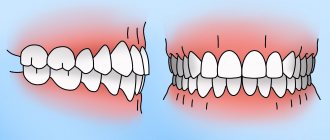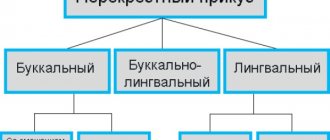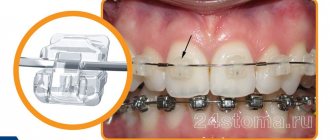When does a child need to have their bite corrected?
Parents should note all important details in the child’s unconscious behavior. Pay attention to how the child breathes, whether his mouth is often open, whether he snores in his sleep, what position the lower jaw is in, whether he likes to gnaw hard objects - these factors have a huge impact on the development of dental pathologies. Take a closer look at the posture and structure of the foot, these are also important indicators of possible violations. Did you find any deviations? Consult a professional.
Risk factors
- difficulties with nasal breathing, for example, due to adenoids or allergies;
- spinal column deformity;
- bad habits;
- genetic predisposition to dental anomalies;
- diseases of the central nervous system.
If the listed risk factors are present, treatment will be effective only with the participation of doctors from related fields. Therefore, it is best to contact myofunctional centers, which unite orthopedists, pediatric dentists, orthodontists and osteopaths. The joint work of specialists guarantees accurate diagnosis and successful resolution of the issue.
Reasons for appearance
Malocclusion develops in early childhood. Often this pathology is hereditary. If the parents suffered from this problem, the child may also develop it. In addition to genetic predisposition, there are other causes of malocclusion:
- Artificial feeding. A newborn baby needs to develop his jaw muscles. When he suckles at his mother's breast, it provides excellent jaw training. If you feed him from a bottle, the jaw muscles will not receive the necessary load, which will provoke the development of pathologies.
- Poor nutrition of a pregnant woman, stress. The lack of essential vitamins and microelements in a pregnant woman’s diet, as well as constant worry and stress, can cause a number of complications in the development of the baby.
- Bad habits of a child. A child's predisposition to thumb sucking, as well as prolonged use of a pacifier, can all contribute to changes in the normal bite.
- Jaw injuries. Facial injuries that result in the absence of some teeth can cause problems with jaw closure. That is why, if you receive a facial injury, you must immediately consult a doctor.
- Breathing through the mouth. Such an innocent problem as nasal congestion can cause serious disturbances in the formation of the jaws. A person constantly breathes through his mouth, and a number of his muscles atrophy over time, which causes a narrowing of the upper jaw.
- Parafunction of the tongue. This disease is characterized by speech impairment. Sometimes a child cannot pronounce certain sounds, as a result of which the articulation of his tongue is impaired - he does not squeeze his teeth enough, which leads to changes in the bite.
The key to successful bite correction is timely fight against it. It is best to deal with this problem from childhood, since the body is in the process of development, and restoration of the normal position of the jaws occurs much faster.
Age for correcting malocclusion in children
You should think about visiting an orthodontist after teething. If necessary, the specialist will prescribe a comprehensive examination and radiography to identify the causes of dental anomalies. Then you should get advice from doctors in related fields. Specialists will determine contraindications, the likelihood of complications and assess the condition of the baby’s entire body. Based on the data obtained, the orthodontist will draw up a treatment plan for approximately 2 years with monthly clinic visits.
Bionator
A bionator is a myofunctional device, two jaw, used in childhood and adolescence, until the end of facial skeleton growth at 14-15 years. A single apparatus that unites the upper and lower jaws consists of a plastic base and additional elements, a vestibular arch, a screw, and, if necessary, further development of the upper jaw. Screws for the development of the upper jaw, the design can also include: lip and cheek bumpers, to eliminate excessive hypertonicity of the muscles of the lips and cheeks, as well as tongue flaps.
The device, unique in its design, allows you to position the jaws in the correct position and create conditions for additional teeth eruption in the correct bite without resorting to treatment with a brace system and additional devices. Helps create harmonious jaws in the correct position by wearing the device at night and 6-7 hours during the day. Excluding meals.
The device improves nasal breathing and also normalizes swallowing function.
Devices for correcting malocclusion in children
In modern dentistry, there are all kinds of devices for correcting malocclusion in children, designed to achieve the following goals:
- prevention of bad habits;
- expansion of the jaw arch;
- correction of speech defects;
- normalization of the functioning of the masticatory muscles;
- tongue position control.
LM activators
These orthodontic structures stimulate the development of the jaw arch, chewing muscles, facial expressions of the child, and promote normal breathing. LM activators are also suitable for getting rid of bad childhood habits - for example, if a baby sucks fingers, bites lips, bites pencils or nails. Due to its effect on the gums and tongue, the device fixes the rudiments of teeth in the desired position and prevents the development of maxillofacial pathologies in the future.
Cap for correcting malocclusion in children
Correcting a child's bite at 3 years old requires minimal costs. At this age, the dental system is still very plastic, and treatment, as a rule, is limited to the use of a cap to correct the bite in children. It is worn only at night to straighten baby teeth and avoid problems in the future when they are replaced by molars. The cap is a bandage made of rubber straps that are fixed on the jaw. The device is also used to correct mesial occlusion - the design restrains the development of the lower jaw and allows the upper jaw to form correctly.
Orthodontic plates
To correct the bite of a child from the age of 4, plates are used - thanks to them, you can align the dentition or prevent them from moving, correct the shape of the palate, and slightly widen the jaw. However, more complex violations cannot be corrected using this device. Orthodontic plates are made from individual impressions and secured in the oral cavity with metal brackets on the outer teeth.
Trainer for correcting malocclusion in children
Trainers for correcting malocclusion in children are called silicone trainers. They are quite soft but durable mouthguards, and are used to correct the bite in a child after 5 years, when the teeth have already been replaced with permanent ones - this way the jaw will develop more correctly. These simulators come in two types:
- elastic and lightweight mouthguards for the correction of dentofacial abnormalities in children aged 6 - 8 years;
- solid and massive trainers for children 8 - 12 years old.
These are standard designs that are produced without taking into account the individual characteristics of the patient. There are no contraindications for their use, and the effectiveness of mouthguards allows you to finally solve problems with bite.
Bracket systems
The general name for devices for correcting malocclusion in children is removable orthodontic structures. They are suitable for children up to 12 years old and correct minor defects. For older children, the orthodontist will most likely recommend braces. They allow you to correct almost any dental anomaly, as they have a strong impact on the entire maxillofacial apparatus. For example, to correct distal occlusion in children, systems with two arches are used that move the teeth in the desired direction.
Facebow braces are effective in correcting deep bites in children because they inhibit the development of the upper jaw to encourage growth of the lower jaw.
If your child, on the contrary, has the upper jaw moved back and the lower jaw forward, correcting the child’s malocclusion will take a little longer, but braces will also cope with the task. In addition, the doctor may prescribe certain surgical procedures, such as lingual frenuloplasty.
Myogymnastics. Rogers proposed a system of gymnastic exercises for the treatment of maxillofacial deformities. The main provisions of this method of training underdeveloped and poorly functioning muscles of the maxillofacial skeleton can be formulated as follows.
1. Contractions of the muscles being exercised must be performed with maximum amplitude (span). 2. The intensity of contraction of such muscles should correspond to its physiological role, but not be excessive. 3. The speed and duration of muscle contractions must be adjusted to the characteristics of the movement being performed. At first they should be slow, gentle and carried out regularly. 4. Between two successive contractions, a rest pause of at least equal duration to the duration of the contraction itself is necessary. 5. Muscle contractions during each exercise are repeated several times until a feeling of slight local fatigue appears. This feeling of fatigue determines the duration of the exercise, beyond which you should not go. 6. Myogymnastics is used in children starting from 4 years of age.
V. S. Kurylenko put these rules as the basis for myogymnastics for dentoalveolar deformities and offers the following exercises.
Exercises for distal and deep bites. 1. The exercise is performed standing with the head slightly thrown back, arms extended along the body and pulled back. The lower jaw is pushed forward until the cutting edges of the lower teeth meet the upper teeth, and then moved posteriorly. 2. After one month, the same exercises are carried out with the only difference being that the lower jaw is pushed forward so that the lower front teeth are placed in front of the upper ones. 3. If the orbicularis oris muscle is underdeveloped (the lips are large, flaccid, turned out, do not close, the mouth is wide), the following exercises are useful: stretching the lips into a tube, as for whistling, and then stretching with the little fingers, as with a wide smile, alternately alternating such positions of the lips. 4. To exercise the orbicularis oris muscle, the index fingers are placed near the corners of the mouth, the lips are not closed, the child tries to close the lips. At this time, without changing the position of the fingers, they create an obstacle to closing the lips.
5. The following exercise is useful for the cheek muscles: puff out your cheeks, close your lips and rhythmically tap your cheeks with your fingertips. 6. If there is a deep bite, exercises 1, 2 can be recommended, and if facial muscles are underdeveloped, exercises 3, 4, 5 can be recommended.
Exercises for mesial occlusion. 1. With the tip of the tongue, the child should press on the palatal surfaces of the upper front teeth until the muscles become tired (for approximately 3-5 minutes). 2. With the head slightly thrown back, alternately open and close the mouth; when closing the mouth, try to reach the posterior edge of the hard palate with the tip of the thrown back tongue. 3. Pull your lower lip, especially if it is drooping, under your upper front teeth and then release it.
Open bite exercises. 1. Press your outstretched fingers in the area of the corners of the lower jaw, set the lower jaw at rest (lower by 1-2 mm), tensing the muscles, clench your teeth, and then take the first position again. Repeat the exercise until the masticatory muscle feels tired. 2. Bite a wooden handle covered with a rubber tube or a school gum with your side teeth.
Exercises for oblique bite. If the oblique bite is caused by a displacement of the lower jaw to the side, you can use the following exercise: open the mouth as much as possible and move the lower jaw towards the incorrect closure of the teeth (the lower teeth overlap the upper ones), then in this position the lower jaw is raised until the teeth are closed and held for 4-5 seconds in this position, after which they are lowered again.
Myogymnastics in orthodontics is a kind of physical therapy. only it is aimed purely at the development, prevention and treatment of various types of abnormalities in the jaw area. Modern orthodontics practices the use of myogymnastics both as an independent process and in combination with other treatment methods.
Pediatric orthodontics uses myogymnastics to treat malocclusions in children. Therefore, special exercises were developed. involving the major muscles in the mouth area. And although myogymnastics in orthodontics is not such a common phenomenon, if problems arise, it can deal with them painlessly.
Of course, there is no point in using myogymnastics without consulting an experienced orthodontist; he will be the one who will be able to determine the cause of any anomalies and recommend the most practical methods for eliminating them. The most famous exercises that allow myogymanism in orthodontics to occupy an important place among other treatment methods.
— Impact on the muscles that are responsible for the movement of the lower jaw is used for deep or distal bite in a child. The exercise is performed standing. The child should bring his shoulders and arms back, his chin up. In this position, try to push the lower jaw forward, then return it to its usual position. (Repeat 5-10 times, several times a day)
- Impact on the masticatory muscles. It is necessary to clench your teeth, it is best if you put a rubber gasket between the lower and upper jaws. It is also beneficial to eat solid foods to develop these muscles.
— Myogymnastics in orthodontics can also be used to develop the orbicularis oris muscle. which is responsible for facial expressions, swallowing and chewing food, and pronunciation. If this muscle is not sufficiently involved in the work, the child’s teeth are constantly visible even in a calm state, and the upper lip seems shortened. Modern orthodontics recommends exercises in the form of blowing out a candle (repeatedly during the day) and tightly closing the lips, with the little fingers stuck in the corners of the mouth (10-15 times, several times during the day).
Orthodontic specialists recommend performing them 3-4 times a day for 5-10 minutes, this is the only way to achieve the desired result. At the same time, parents should ensure that the child performs all exercises with maximum amplitude and is not lazy - otherwise the necessary muscles will not actively participate in the process.
Myogymnastics in orthodontics to correct lip closure. It is better to do a session of such exercise while sitting on a chair, in front of a mirror, in order to see everything that is being done.
- stretch your lips out like a tube, then stretch them wide into a smile.
- stretch your lips forward, pretending to be a mouthpiece, you can say something, hold it for a few seconds and return it back.
- with an effort, close your lips completely, draw in air and inflate your cheeks, and then, without opening your lips, squeeze out the air with your fists so that it gradually comes out through your lips.
- with your lips tightly closed, take in air under your upper lip, then in the same way under your lower lip.
- move tightly closed lips to the sides.
- with visible effort, blow out a stream of air through lips folded into a tube, as if blowing out a candle.
Myogymnastics in orthodontics for the tongue. Try to make children's orthodontics perceived by the child as a game, learning acting skills in front of a mirror, so that he would be interested in doing gymnastics.
- exercise for hours. With your lips tightly closed, move your tongue under the upper lip, then under the lower lip in a circle, imitating the movement of the hand of a clock.
- Punishment exercise for the tongue. Extend your tongue, place it on your lower lip and, closing your upper lip, try to slap your tongue.
- exercise let's paint a new ceiling. Using the tongue as a paint brush we paint our ceiling, which is the sky. We don't miss anything, everything must be painted.
- and now construction work. You need to imitate the operation of a jackhammer, making similar sounds: Ddddddd.
- the next exercise is performed in this way: press your tongue to the roof of your mouth with your mouth open, then close your teeth tightly and swallow saliva. holding the tongue in the established position.
Tongue-tied. Myogymnastics. Tongue-tied (dyslalia) refers to functional disorders of the speech organs that have a negative impact on the formation of the dental system. It is customary to distinguish between a general (diffuse) disorder in the pronunciation of speech sounds and a partial disorder, expressed in a violation of the pronunciation of individual sounds. Changes in pronunciation are expressed in the form of distortion of the sound or its complete loss, in the form of replacing one sound with another (for example, the sound “L” is replaced by the sound V) or in the form of slurred pronunciation. Among the different types of tongue-tiedness, the most common is the incorrect pronunciation of the sounds R and L (rotacism), hissing and whistling sounds (sigmatism). Tongue-tiedness also includes nasal speech. Tongue-tiedness is significantly common among school-age children (N. A. Omelchenko, 1961).
In the etiology of tongue-tiedness, a certain place is occupied by various developmental disorders of the speech organs and the dental system: macroglossia, shortened frenulum of the tongue, high, narrow or, conversely, too flat hard palate, short soft palate, congenital cleft palate, adenoid growths in the nasopharynx, adentia, as well as .bite anomalies (prognathia, progenia, open bite) and dentition defects (diastema, tremata, absence of anterior teeth). All these factors cause incorrect position of the tongue, lips and abnormal passage of the air stream during the pronunciation of speech sounds. At the same time, incorrect speech articulation, associated with the insertion of the tongue between the dentition and changes in the functional activity of the muscles of the perioral region and pharynx, contributes to the occurrence of anomalies and perpetuates them.
One of the common causes of tongue-tiedness is inattentive education of children who imitate incorrect speech (incorrect speech environment). Rarer causes include hearing loss and diseases of the central nervous system.
The treatment of tongue-tied speech is carried out by specialists - speech therapists, who teach the correct articulation of the speech organs when pronouncing individual sounds. If there is a deviation from the organs of the dental system, complex treatment is required: surgical (dissection of the short frenulum of the tongue, plastic closure of the palate defect, removal of adenoid growths in the nasopharynx), orthopedic (elimination of malocclusions and prosthetics) and speech therapy.
Myogymnastics is a method of physical therapy used in orthodontics for the prevention and treatment of anomalies of the dental system. Myogymnastics can be used independently (mainly for primary dentition) or in combination with hardware treatment (during changing teeth and with permanent dentition).
Considering the regulating influence of the masticatory and facial muscles on the proper development of the jaws and the state of the bite. A. Rogers and other authors have developed a set of exercises for training the muscles of the maxillofacial area. This complex includes: 1) Exercises for muscles. protruding lower jaw, indicated for microgenia, distal occlusion, deep occlusion. To do this, the child, standing, pulls his shoulders and arms back, raises his chin and slowly pushes his lower jaw forward and back as far as possible; exercises are repeated several times in a row, several times a day.
2) Exercises to train the masticatory muscles. consisting in clenching the teeth, preferably with additional resistance in the form of a rubber gasket between the dentition. Children should also be encouraged to chew solid foods.
3) Exercises for training the orbicularis oris muscle are very varied. The orbicularis muscle is not only a facial muscle; it is involved in the acts of sucking, chewing and swallowing food, pronunciation of speech sounds, etc. With reduced functional activity of the orbicularis oris muscle, the oral fissure looks wide, the lips are open, the upper lip is shortened, and teeth are constantly visible. This condition accompanies the child’s habitual mouth breathing and is usually combined with malocclusion.
Increased tone of the orbicularis oris muscle. in particular, its bundles located in the lower lip are observed with some bad habits - biting the lower lip, improper swallowing (see Improper swallowing). In such cases, a distal bite is often observed, the treatment of which is difficult due to the existing bad habit.
Myogymnastics for the orbicularis oris muscle consists of closing the lips with an obstacle in the form of fingers (little fingers) placed in the corners of the mouth or in the form of a special disk. You can also recommend exercises for the lips in the form of blowing out a candle flame, massaging the upper lip to the sides and down.
Myogymnastics is a good remedy that prevents relapse of the anomaly, provided that it is carried out systematically and under control. The availability of the method allows it to be used in the treatment of young children in kindergartens and primary schools under the guidance of educators.
Alternative techniques
Mouth guards for bite correction
As an alternative to braces, the orthodontist may suggest a mouth guard to correct the bite in children over 17–18 years of age. With their help, it is possible to correct defects in the upper dentition and correct the bite on the lower jaw in children.
Myotherapy
Another alternative option for correcting malocclusion in children is myotherapy. The essence of this technique is to perform special exercises to correct the bite in children. As a result of regular training, the muscular system begins to work correctly, and the teeth are aligned. The peculiarity of this method is that it can be used both as an independent and as an additional means for correcting dental defects. It is suitable for children no older than four years old, so it is impossible to do without the supervision of an adult during the exercises.
However, myomotherapy is not suitable for every child, as it has the following contraindications:
- impaired mobility of the jaw arch;
- muscle hypertrophy;
- severe dental anomalies;
- deformation of the maxillofacial system after illness or injury.
Surgery
Surgery also applies to correcting malocclusions without braces in older children, but this method is not common and is used as a last resort. Correction of malocclusion in children under 12 years of age by surgery, as a rule, is carried out only for special indications. These include the following defects:
- congenital malformation of the jaw;
- facial asymmetry;
- chin dysplasia;
- skeletal abnormalities;
- deformation of the cranial vault.
In all other cases, the specialist will try to solve the problem in a less radical way, for example, with braces or prosthetics.
Do you know what bite exercises and an orthodontic consultation have in common?
Both exercises and consultation with a Star Smile orthodontist are FREE!
But if you need to look for exercises somewhere on your own, and it is not clear which ones are suitable for you and which are contraindicated, then a competent consultation with a good orthodontist in your city - and, moreover, free of charge for you - will definitely not have any contraindications. Why do we offer you a free consultation? Star Smile is a leading Russian manufacturer of aligners; certified orthodontists work in more than 70 (!) cities of Russia. And we have the lowest prices with a very high quality of treatment. Our mission is to make orthodontic treatment accessible to the majority of Russian citizens. You always have a choice - to be treated under the supervision of a doctor or to do it yourself. But getting competent advice and understanding how and why the problem of crooked teeth arose is very important.
Exercises to correct bite in children
The orthodontist selects exercises to correct the bite individually for each child, taking into account the structural features of the jaw and the severity of the pathology. Myogymnastics can be performed by parents themselves, who have learned the technique from a specialist, or by teachers and nurses in groups of children with the same disabilities.
- The lesson includes several exercises for the muscles of the tongue and oral cavity.
- Hold a sheet of cardboard with your lips while breathing through your nose.
- Move your lower jaw forward, biting your upper lip with your teeth.
- Pull out your lips with a tube.
- Puff out your cheeks with your lips closed.
- Massage your lips.
- “Click” your tongue.
- Touch each tooth with your tongue one by one.
- Hold some water in your mouth while breathing through your nose.
Myogymnastics must be performed daily at the same time until fatigue appears, taking short breaks between exercises. Only in this case will it be effective and bring the expected results.
"Fagga" device
The upper jaw appliance is used for the corpus development of the upper jaw, more often in patients with underdevelopment of the anterior premaxillary part of the upper jaw. The device is non-removable, fixed motionlessly using special cement and filling material in the oral cavity, and is activated by the doctor during a routine examination. It consists of metal rings, additional elements, and springs, which, when activated, create an extension of the premaxillary part of the upper jaw. A place is created for missing teeth or previously removed teeth for orthodontic reasons. More often when removing canines and premolars from patients. The wearing period of this device is 5-6 months, during this period of time we have the opportunity to grow the premaxillary part of the upper jaw, create the necessary volume and space for implantation planning. The duration of wearing is individual and depends on the complexity of the case; special attention should be paid to hygiene, since the device is non-removable and contains a large number of additional elements. To prevent the development of caries and dental plaque.
How much does it cost to correct malocclusion in children?
Correcting a bite in young children cannot be called expensive. Doctors use simple and inexpensive orthodontic appliances or recommend exercises. But an older child requires more serious treatment, and accordingly, the cost will be slightly higher. The cost of treatment depends on the severity of the pathology and the age of your child. The price of correcting defects with a plate or trainers for a 5-year-old child will vary from 3,000 to 6,000 rubles. Installing braces for children over 12 years of age will cost 100,000 - 300,000 rubles. Treatment with aligners, costing from 169,000 rubles, is available to adolescents aged 16–17 years.
Any dental correction in children should begin with a thorough examination. Correct and timely identification of problems makes it possible to eliminate dental anomalies in almost all patients. The success of treatment depends mainly on its timeliness. The sooner parents show their child to a professional, the greater the chance of eliminating the defect.
How to fix teeth without braces
Orthodontists have many techniques in their arsenal to help straighten teeth or correct bites. I work with children and adults. Without braces, using aligners, more than three hundred of my patients have already received effective help; their problems have been successfully resolved.
Plates for children
If occlusion defects or crooked teeth are found in a child, then it is rational to use special plate devices or select other methods. I developed a training course on the correction of malocclusions using aligners in children, which became popular in the country and abroad. During the visit, we will discuss the nuances of the problem and select a method for your baby that is gentle and corrects deficiencies. A child’s bones are plastic, so changes occur quickly - results are visible within a couple of months. In addition, at a tender age, only teeth correction without braces is possible. The disadvantages of such treatment are minor temporary changes in diction, increased salivation during the adaptation stage.
Aligners
You can straighten your teeth without braces using aligners. These are plastic trays that help align units and form a correct bite.
They are made of transparent material, so they are practically invisible on the teeth. Aligner rulers are made individually based on the results of 3D computer modeling based on digital impressions. The loads are accurately calculated, the pressure on each tooth is determined, and each stage of the correction process is predicted. Easyliners and invisaliners are improved designs made from hypoallergenic synthetics. They allow you to easily brush your teeth and can be removed and put on yourself. The wearing period is from 8-10 months, 20-24 aligners may be needed, the structures are replaced at different stages of pathology correction. The method is effective and its cost is paid off by the quick results and patient comfort. Disadvantages of treatment are the need to frequently change mouth guards and pain during adaptation. Modern aligners are durable, flexible, and their care is hassle-free.
Functional devices
A visit to the orthodontist will help you figure out how to straighten your teeth without braces. It is possible to use myofunctional devices. I successfully work with trainers and activators. There are models of trainers that will help correct bites at an early age - from 3-4 years. This is a simple and painless treatment option for the baby. Ordinary plates correct irregularities, and trainers relieve muscle tension, correct the position of teeth, and the bite is corrected smoothly, without effort. Facial features become proportional.
Of course, there is now a huge selection of offers from clinics and dentists. And sometimes it is very difficult to choose who to go to for treatment.
In these cases, a few points always help:
- Explore the doctor's clinical experience
- Read reviews about it
- Perhaps there are friends or acquaintances in your circle who have already been treated by a specialist you are interested in
And of course, a face-to-face consultation is important. So don't hesitate to make an appointment. We will get to know you or your child, clarify the diagnosis, and select a method of straightening teeth without braces that will be effective and affordable. And we will answer all your questions. We have no doubt that you will like it with us!
Orthodontic plates for jaw development
An orthodontic plate for the upper jaw consists of a plastic base and additional elements, such as a vestibular arch, a screw for expansion, and a clasp for fixation. The plate apparatus is used on both the upper and lower jaws, and depending on the number of screws and the task at hand, their directed development of the jaws is created. A place is created for permanent teeth, previously extracted teeth, and missing teeth. Therefore, they can be used in both children and adults, with differences in the number of activations over time. The devices are plate-type, removable, and are removed only, as a rule, for hygiene of the oral cavity and the device itself. The duration of wearing depends on the complexity of the case and the degree of narrowing of the jaw. Activation of the device and screws is carried out directly with the patient himself, on the recommendation of the attending physician.











